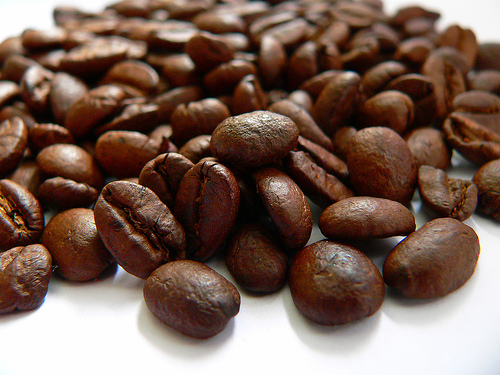Caffeine Mechanism of action

Cas No. [58-08-2]
Caffeine's principal mode of action is as an antagonist of adenosine
receptors in the brain.
Caffeine readily crosses the blood–brain barrier that separates the
bloodstream from the interior of the brain. Once in the brain, the
principal mode of action is as a nonselective antagonist of
adenosine receptors. The caffeine molecule is structurally similar
to adenosine, and binds to adenosine receptors on the surface of
cells without activating them (an "antagonist" mechanism of action).
Therefore, caffeine acts as a competitive inhibitor.
Adenosine is found in every part of the body, because it plays a
role in the fundamental ATP-related energy metabolism, but it has
special functions in the brain. There is a great deal of evidence
that concentrations of brain adenosine are increased by various
types of metabolic stress including anoxia and ischemia. The
evidence also indicates that brain adenosine acts to protect the
brain by suppressing neural activity and also by increasing blood
flow through A2A and A2B receptors located on vascular smooth
muscle. By counteracting adenosine, caffeine reduces resting
cerebral blood flow between 22% and 30%. Caffeine also has a
generally disinhibitory effect on neural activity. It has not been
shown, however, how these effects cause increases in arousal and
alertness.
Adenosine is released in the brain through a complex mechanism.
There is evidence that adenosine functions as a synaptically
released neurotransmitter in some cases, but stress-related
adenosine increases appear to be produced mainly by extracellular
metabolism of ATP. It is not likely that adenosine is the primary
neurotransmitter for any group of neurons, but rather that it is
released together with other transmitters by a number of neuron
types. Unlike most neurotransmitters, adenosine does not seem to be
packaged into vesicles that are released in a voltage-controlled
manner, but the possibility of such a mechanism has not been
completely ruled out.
Several classes of adenosine receptors have been described, with
different anatomical distributions. A1 receptors are widely
distributed, and act to inhibit calcium uptake. A2A receptors are
heavily concentrated in the basal ganglia, an area that plays a
critical role in behavior control, but can be found in other parts
of the brain as well, in lower densities. There is evidence that A
2A receptors interact with the dopamine system, which is involved in
reward and arousal. (A2A receptors can also be found on arterial
walls and blood cell membranes.)
Beyond its general neuroprotective effects, there are reasons to
believe that adenosine may be more specifically involved in control
of the sleep-wake cycle. Robert McCarley and his colleagues have
argued that accumulation of adenosine may be a primary cause of the
sensation of sleepiness that follows prolonged mental activity, and
that the effects may be mediated both by inhibition of
wake-promoting neurons via A1 receptors, and activation of
sleep-promoting neurons via indirect effects on A2A receptors. More
recent studies have provided additional evidence for the importance
of A2A, but not A1, receptors.
Some of the secondary effects of caffeine are probably caused by
actions unrelated to adenosine. Like other methylated xanthines,
caffeine is both a
1. competitive nonselective phosphodiesterase inhibitor which raises
intracellular cAMP, activates PKA, inhibits TNF-alpha and
leukotriene synthesis, and reduces inflammation and innate immunity
and
2. nonselective adenosine receptor antagonist (see above).
Phosphodiesterase inhibitors inhibit cAMP-phosphodiesterase (cAMP-PDE)
enzymes, which convert cyclic AMP (cAMP) in cells to its noncyclic
form, thus allowing cAMP to build up in cells. Cyclic AMP
participates in activation of protein kinase A (PKA) to begin the
phosphorylation of specific enzymes used in glucose synthesis. By
blocking its removal caffeine intensifies and prolongs the effects
of epinephrine and epinephrine-like drugs such as amphetamine,
methamphetamine, or methylphenidate. Increased concentrations of
cAMP in parietal cells causes an increased activation of protein
kinase A (PKA) which in turn increases activation of H+/K+ ATPase,
resulting finally in increased gastric acid secretion by the cell.
Cyclic AMP also increases the activity of the funny current, which
directly increases heart rate. Caffeine is also a structural
analogue of strychnine and like it (though much less potent) a
competitive antagonist at ionotropic glycine receptors.
Metabolites of caffeine also contribute to caffeine's effects.
Paraxanthine is responsible for an increase in the lipolysis
process, which releases glycerol and fatty acids into the blood to
be used as a source of fuel by the muscles. Theobromine is a
vasodilator that increases the amount of oxygen and nutrient flow to
the brain and muscles. Theophylline acts as a smooth muscle relaxant
that chiefly affects bronchioles and acts as a chronotrope and
inotrope that increases heart rate and efficiency.
Caffeine has a significant effect on spiders, which is reflected in
the construction of their webs.

>>
New Product
Introduced :
Oseltamivir
Phosphate,
Phenyl Propanolamine,
Phenylephrine,
Etafedrine

|

 We all know that one of the most
powerful chemical compounds found in both coffee and tea is
caffeine. Has caffeine become an important part of your daily life?
Did you know We all know that one of the most
powerful chemical compounds found in both coffee and tea is
caffeine. Has caffeine become an important part of your daily life?
Did you know
Article : What Is Caffeine?
 Caffeine is a drug that is naturally
produced in the leaves and seeds of many plants. It's also produced
artificially and added to certain foods. Caffeine is defined as a
drug because it stimulates the central nervous system, causing
increased alertness. Caffeine gives most people a temporary energy
boost and elevates mood. Caffeine is a drug that is naturally
produced in the leaves and seeds of many plants. It's also produced
artificially and added to certain foods. Caffeine is defined as a
drug because it stimulates the central nervous system, causing
increased alertness. Caffeine gives most people a temporary energy
boost and elevates mood.
Caffeine is in tea, coffee, chocolate, many soft drinks, and pain
relievers and other over-the-counter medications. In its natural
form, caffeine tastes very bitter. But most caffeinated drinks have
gone through enough processing to camouflage the bitter taste.
Teens usually get most of their caffeine from soft drinks and energy
drinks. (In addition to caffeine, these also can have added sugar
and artificial flavors.) Caffeine is not stored in the body, but you
may feel its effects for up to 6 hours.
![Caffeine Cas No. [58-08-2]](caffeine/CAFFEINE%20LOGO%20SMALL.bmp)
|


